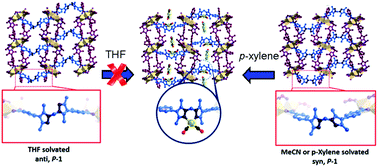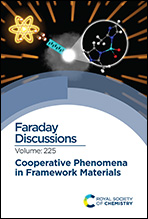MOF matrix isolation: cooperative conformational mobility enables reliable single crystal transformations†
Abstract
Obtaining structural information for highly reactive metal-based species can provide valuable insight into important chemical transformations or catalytic processes. Trapping these metal-based species within the cavities of porous crystalline hosts, such as metal–organic frameworks (MOFs), can stabilise them, allowing detailed structural elucidation by single crystal X-ray diffraction. Previously, we have used a bespoke flexible MOF, [Mn3L2L′] (MnMOF-1, where L = bis-(4-carboxyphenyl-3,5-dimethylpyrazolyl)methane and L = L′, but L′ has a vacant N,N′-chelation site), which has a chelating site capable of post-synthetically binding metal ions, to study organometallic transformations and fundamental isomerisation processes. This manuscript will report the underlying conformational flexibility of the framework, demonstrate the solvent dependency of post-synthetic metalation, and show that the structural flexibility of the linker site and framework are critical to controlling and achieving high levels of metal loading (and therefore site occupancy) during chemical transformations. From these results, a set of design principles for linker-based “matrix isolation” and structure determination in MOFs are derived.

- This article is part of the themed collection: Cooperative phenomena in framework materials


 Please wait while we load your content...
Please wait while we load your content...